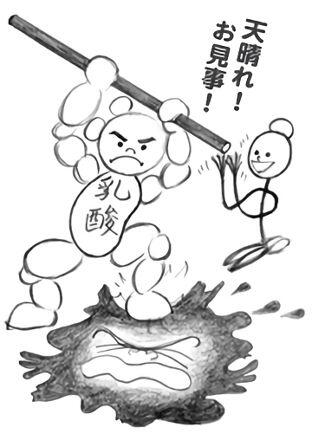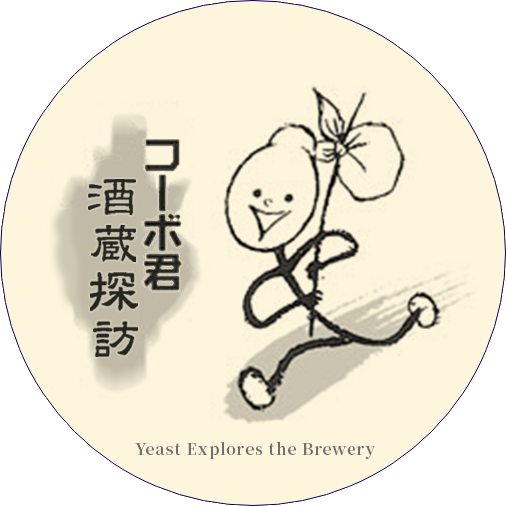| Yeast |
“Today I’m going to meet Daishichi’s lactic acid bacteria in the new kimoto room. How are you doing?” |
| Daishichi’s Lactic Acid Bacteria |
“Hi, Yeast! We’re very fine. When we were moved from the old brewery to the kimoto room in the new brewery, everyone was very careful.” |
| Yeast |
“I’m relieved to hear that – all of you are the greatest treasure of the brewery.” |
| Daishichi’s Lactic Acid Bacteria |
“Thank you. There is an infinite variety per brewery among the lactic acid bacteria which are the key to the kimoto method. The stable existence of good lactic acid bacteria is an important element in the taste of the sake.” |
| Yeast |
“Yes, that’s why you go on every day without interruption.” |
| Daishichi’s Lactic Acid Bacteria |
“In case only a small number of bottles of kimoto sake is made every year, such stability is impossible.” |
| Yeast |
“Can you tell me more about the function of lactic acid bacteria?” |
| Daishichi’s Lactic Acid Bacteria |
“It is to keep the tank in which the yeast grows clean. The lactic acid made by us, lactic acid bacteria, has the power to drive away unwanted microbes such as wild yeast.” |
| Yeast |
“We depend on you!” |
| Daishichi’s Lactic Acid Bacteria |
“Only sake yeast like you will continue to multiply even in lactic acid. Finally it is the alcohol that destroys us lactic acid bacteria, and only the yeast will grow with 100% pureness. We are your helpers.” |
| Yeast |
“A wonderful job. But do you never fail in such an important task?” |
| Daishichi’s Lactic Acid Bacteria |
“Sometimes. When kimoto is made in a skillful way, the result will be perfect, but if the technique is crude, it will fail. In the Meiji period 8% of total kimoto production in Japan failed. That’s why the National Research Institute developed yamahai and sokujomoto.” |
| Yeast |
“I know. Those simplified methods helped significantly reduce the number of failures.” |
| Daishichi’s Lactic Acid Bacteria |
“But the taste is not the same as kimoto. The strong point of kimoto is the quality of the yeast which has been carefully selected in a competitive environment.” |
|
 |
| Yeast |
“In other words, weak yeast and yeast that can’t stand a low temperature has been wiped out in the struggle for survival.” |
| Daishichi’s Lactic Acid Bacteria |
“Yes, only strong yeast has offspring. This yeast is completely different from the sokujomoto yeast which only has to think about proliferating in a relaxed environment.” |
| Yeast |
“The strong kimoto yeast will continue a healthy fermentation until the last stage of the mash. And that is linked to sake with a clear aftertaste.” |
| Daishichi’s Lactic Acid Bacteria |
“But yeast also has a lifespan, as one yeast cell can normally only split 24 times. If the nutrition of the environment in which it grows up is too good, it gets fat and stops working, and will uselessly multiply until it gets old.” |
| Yeast |
“On the other hand, kimoto yeast which grows in the opposite type of environment, doesn’t split very often and remains young. Well-trained, young and slim yeast is at its best in a ginjo mash with low temperatures and so little nutrition it almost starves. Here, look at my muscles! No, no, I have to steel myself by restricting my food. Also in the future I want to help Daishichi with kimoto brewing!” |
| Daishichi’s Lactic Acid Bacteria |
“Yes, you have to teach important things to the many new yeast particles being born now.” |
| Yeast |
“Fine, leave that to me!” |
| Daishichi’s Lactic Acid Bacteria |
“You have to keep it up every day, Yeast. Shall we next time study more about kimoto brewing?” |
| Yeast |
“Yes, I’m looking forward to that!” |





